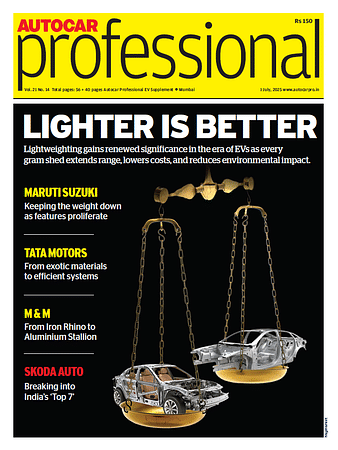Transforming India's commercial vehicle landscape to make sustainable mobility a reality
Advancing decarbonisation in India's commercial vehicle industry through diesel innovations, natural gas, electric, and hydrogen technologies, paving the way for a sustainable and efficient future while meeting long-term emission reduction targets.
As India advances its commitment to balancing economic growth with environmental sustainability, the medium and heavy commercial vehicles (M&HCVs) sector stand at a critical juncture.
Serving as the backbone of India’s logistics and passenger mobility ecosystem, the M&HCV sector remains an indispensable enabler of the nation’s progress. However, with its pivotal role, the sector is also a significant contributor to road transport emissions.
With India striving to achieve its net-zero emissions by 2070, the M&HCV sector must embrace cleaner, more efficient and new powertrain technologies to ensure its growth aligns with sustainability imperatives. This shift is not merely about compliance with future emission norms, but a paradigm shift, redefining how the sector underpins India’s development agenda while delivering environmental benefits.
In this transition, diesel propulsion technologies continue to dominate the Indian commercial vehicle landscape. The diesel technologies have undergone a remarkable evolution, adapting to stringent emission regulations while continually improving efficiency and versatility.
From early iterations to the latest BS-VI Stage II engines, diesel powertrains have significantly reduced the tailpipe emissions and enhanced fuel efficiency. This progress underscores diesel’s adaptability in meeting diverse application needs from urban transport to demanding long-haul operations.
Its continued relevance lies in addressing the immediate and varied requirements of stakeholders while complementing the emerging sustainable technologies.
Simultaneously, the industry recognizes that the future lies in embracing a diversified powertrain mix of new fuels and technologies such as natural gas, electric, and hydrogen-based solutions.
These alternatives are essential to cater to varied operational demands and support the broader shift to cleaner mobility solutions. Natural gas powertrains, particularly those utilising Liquefied Natural Gas (LNG), are emerging as the most pragmatic solution today for reducing carbon intensity of heavy-duty long-haul applications.
These technologies offer a compelling combination of reduced emissions, operational cost efficiency, and suitability for long-haul freight operations. Natural gas produced from bio-feedstock can enable zero to negative carbon emissions from well to wheel.
In parallel, aided by progressive government initiatives such as FAME (Faster Adoption and Manufacturing of Electric Vehicles) and PM E-Drive (Prime Minister Electric Drive) schemes, urban commercial segments, such as buses and light commercial vehicles, are witnessing accelerated adoption of electric powertrains.
The predictable nature of intra-city routes and the availability of regular charging opportunities align seamlessly with current technology capabilities. Moving forward, electric powertrains are expected to expand into niche heavy-duty applications, particularly where shorter distances and fixed route operations provide a conducive environment.
However, the majority of heavy commercial vehicles continue to operate over long, unpredictable routes, necessitating solutions that offer extended range and rapid refueling capabilities.
In this context, hydrogen-based powertrains represent the next frontier for the decarbonization of M&HCV sector. With high energy density and zero-carbon emissions, when coupled with green hydrogen, it offers a viable, long-term solution for sustainable mobility.
This not only enables the decarbonization of long-haul freight operations but also positions India to achieve energy self-sufficiency while enhancing supply chain resilience. Emerging and innovative technology like hydrogen based internal combustion engines provides a more practical solution for the cost-conscious Indian transport industry, when compared with hydrogen fuel cell.
With lower initial cost, less sensitivity to hydrogen fuel purity, and familiar technology for suppliers and aftermarket service, it offers a more practical solution for India to embrace hydrogen economy for transport sector.The transition to cleaner technologies presents both opportunities and challenges.
Key among them is the development of enabling infrastructure, such as refueling corridors for LNG and charging networks along India’s national and state highways. Additionally, the high upfront costs of alternative fuel vehicles, coupled with the evolving maturity of certain technologies, add layers of complexity to the shift.
Nonetheless, policy frameworks such as BS-VI emission norms, CAFE (Corporate Average Fuel Efficiency) regulations, PLI (Production Linked Incentives)), and the PM E-DRIVE scheme are providing the necessary thrust to drive industry-wide transformation. Investments in R&D, coupled with innovation across powertrain technologies, are creating opportunities for Indian manufacturers to build globally competitive capabilities.
Early adoption of multi-fuel powertrains will position India as a frontrunner in sustainable mobility solutions, unlocking export avenues and economic benefits.
More than a technological transition, the transformation of M&HCV sector demands a holistic ecosystem approach.
Scaling infrastructure, building collaboration, and driving consumer adoption will be instrumental to success. Public-private partnerships will play a catalytic role in building the necessary ecosystem, while financial incentives, fleet-modernization programs, and targeted consumer awareness campaigns can accelerate the adoption of clean technologies.
Furthermore, forward-thinking policies, long term industry and infrastructure roadmap, and consistent regulatory support will ensure an enabling environment for sustainable growth.
As India advances on its journey toward sustainable mobility, the M&HCV sector has a unique opportunity to emerge as a global leader in technological innovation and environmental responsibility. By embracing a multi-technology decarbonization strategy and promoting deep collaborating across the ecosystem, the sector can redefine the future of commercial sector, driving India’s progress while contributing to a cleaner, greener tomorrow.
Nitin Jirafe is a Managing Director of TATA Cummins Pvt Ltd and Head, Engine Business, Cummins India. The views expressed are purely those of the author's.
RELATED ARTICLES
A Multi-Fuel Future: The Critical Role of Auto LPG in India’s Energy Strategy
As India targets net zero by 2070, Auto LPG emerges as a practical, low-emission fuel alternative, supporting energy div...
Digital Shielding: A Strategic Imperative for the Indian Automotive Industry
As digitalization reshapes manufacturing, Indian automotive firms must adopt AI, cloud platforms, and smart logistics to...
Parking Woes in Crowded Areas: How It Affects Common People's Mental Health and Time
Parking woes in Indian metros go beyond traffic and inconvenience—impacting mental health, productivity, and everyday li...





 31 Dec 2024
31 Dec 2024
 5667 Views
5667 Views





 Sarthak Mahajan
Sarthak Mahajan




